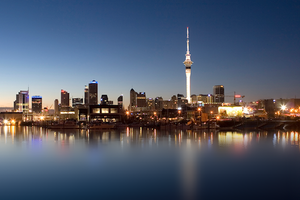
The light aircraft banks left, straightens and ahead of us are the two biggest mountains in the country, standing sentinel over a dramatic landscape of snow-capped peaks and massive glaciers carve their way through rainforests to the edge of the Tasman Sea. Mt Cook and Mt Tasman impose themselves on this terrain, and dwarf our eight seater fix wing plane, and as we continue directly towards them I’m a little concerned the pilot is just as transfixed by the spectacle and unaware of just how close we are now to the snowcapped peaks. Right on cue, the pilot pulls back and sweeps smoothly to the right and we drop down over the next valley to be confronted by Tasman Glacier, New Zealand’s biggest at more than 20 kilometres.
The Magic Of Westland
I had been warned by Kiwi friends that this part of the world is the type of place that has to be seen to be believed, and “Westland” as it’s simply known to New Zealand locals, can easily overload the senses with its outrageous landscapes. On my first trip to the South Island, I’d “done” the World Heritage listed Milford Sound no less and was expecting a slightly different and more understated version on the west coast. A little perspective on this: the sheer rock faces of Milford Sound drop around 1,200 metres into the water while Mt Cook National Park has 19 peaks at more than 3,000 metres with glaciers that almost reach the Tasman Sea. Comparisons like this of course can be unfair but the fact remains that the vast and unique landscape in this remote area of New Zealand captured the imagination of early explorers, and settlers who proudly claim to live in the most beautiful part of the country.
At the heart of it is the pretty village of Franz Josef, named after the Franz Josef Glacier which is one of the region’s most famous attractions, just five kilometres from the town centre. The glacier is what’s drawn intrepid visitors here for the past 100 years or more and the area has a reputation as a bit of rough-and-tumble place for explorer types. The accommodation choices in the past have reflected this, but now explorers with an eye for refinement can stay at Te Waonui Forest Retreat (www.scenichotelgroup.co.nz), which adds an element of luxury to the rugged outdoorsy atmosphere of Franz Josef and surrounds. The resort has 100-rooms overlooking the area’s lush forest, and the design innovations have embraced the latest developments in sustainable accommodation, including the use of renewable materials. Te Waonui was also designed to minimise the impact on the site and was built around the natural environment, to create the feeling that you’re staying right in the forest.
Riding The TranzAlpine Train
It’s a slice of indulgence which is worth the journey on its own, but getting down to this part of the world has always been a bit of an issue. Christchurch on the east coast of the South Island is perhaps the best starting point which means a trek over the Southern Alps is needed to reach the west coast and the TranzAlpine Train is a transport solution and sightseeing trip rolled into one. It’s a daily train trip, rated one of the world’s great scenic railway journeys, which travels from Christchurch to Greymouth at the northern end of the west coast. This is an experience in itself and not just a bit of a trundle for train buffs: from the Canterbury Plains and its farmland to the spectacular gorges and river valleys of the Waimakariri River and over the Southern Alps themselves past snowcapped mountains, it’s a great introduction to the scale and beauty of the South Island.
The 224 kilometre journey takes four and a half hours, and from Greymouth the best way to tackle the west coast is by car. The 170 kilometre drive down to Franz Josef usually takes around three hours non-stop but there are enough diversions on the way to blow this schedule out. Just 10 kilometres south of Greymouth is the first diversion, a man-made one in the form of Shantytown which is a recreated 19th century gold rush village made up of around 30 historic buildings fitted out with original relics which gives it the feel of a town that’s just been suddenly deserted. They’ve also rebuilt an original steam train and section of track used to transport gold and conduct gold panning lessons to add a bit of fun and interactivity to the place. The road to Franz Josef reveals the wild west coast in all its glory and along the way we learn that this area is also home to one of the most endangered of the five kiwi species - the rowi. Less than 400 rowi kiwis remain in the Okarito Forest and local Department of Conservation scientists reveal how these nocturnal birds are tagged and tracked with the latest high-tech transmitters. It’s my first sighting of a kiwi in the wild, and I’m told this is an experience most New Zealanders would kill for.
Flight seeing Over Mt Cook National Park
The flightseeing trip over the Mt Cook National Park and its glaciers helps put the sheer scale of the region in perspective, and we’re told by locals the next thing to do is to physically get onto the ice of a glacier. Hiking the Franz Josef Glacier (www.franzjosefglacier.com) is what most people come here for, and our guided half day trek begins with a 45 minute walk from the car park through the glacier valley to the terminal face, or bottom of the glacier ice. We strap on crampons over water proof boots and the fun begins. The glacier looks daunting from the base, and we climb stairs which the guides have literally carved into the ice with their picks and even with the metal crampons, it’s all a lot easier than expected. We crunch through the blue ice up to 350 metres and drop into a deep crevasse just wide enough to fit us through and use ropes and carved ledges to emerge from the top with a vista of the glacier valley, the Waiho River and ocean as our reward.
Most visitors to Franz Josef climb the glacier, or at least view it from the valley, and miss out on checking out everything else in the town including the quad biking reserve. It’s an impressive area of land set aside specifically for quad biking and it’s the only one of its kind offering glacial views and a track that takes in glacial rivers, rain forests and lots of glorious mud. And there’s the more serene activities such as the Glacier Country Lake Tours where you can sit back on a comfy boat and glide around Mapourika Lake and take in the unique flora and fauna of this part of the world with Mt Cook as the backdrop, or you can wallow in the Glacier Hot Pools at the back of Te Waonui which are fed by local rivers and heated for the perfect finish to a day of exploring. It’s all a little overwhelming, and as the great 19th century New Zealand explorer Charles Douglas, himself a West Coast resident, famously said: “Nature’s true wonders don’t disclose themselves to day trippers. This is a place to linger.”
- By:
- Ben Hall










